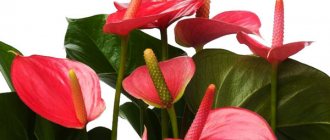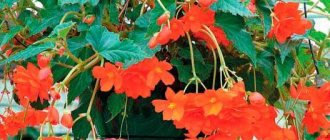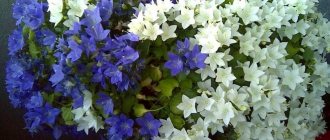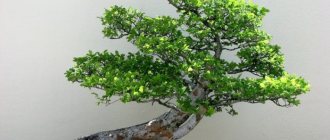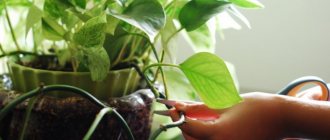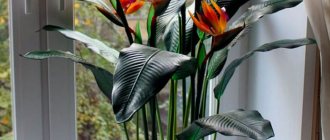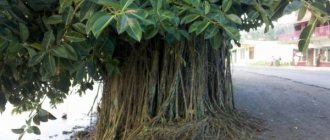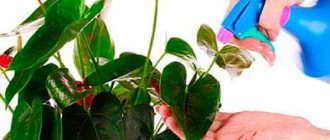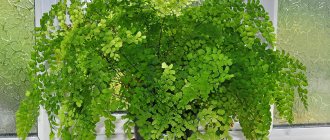Botanical description
Anthurium orange is a perennial and fast-growing plant. The height of the flower can be from 50 cm to 1 m (depending on the variety), and has an aerial root system.
The color range of the bedspread varies from light orange to a more saturated orange hue; the bract, like the leaves of the plant, can have a glossy or matte surface. Leaves are round or heart-shaped.
Today there are many bred hybrids of this species.
Reproduction
Anthurium Zizou is easily propagated in several ways: green cuttings, seeds or pups. The last method is the most convenient:
- The adult flower is carefully removed from the pot.
- Children with roots are separated from the mother plant.
- The seedlings are placed in separate containers filled with substrate.
To help the babies take root faster, the planting containers are covered with glass (polyethylene). The soil is periodically moistened, and the shelter is opened slightly for ventilation once a day.
What else is it called?
“Male happiness” is the general name for anthuriums, regardless of the variety or color of the cover, but orange anthurium has its own. “Fire tongue” is what people call it because of the similarity of the orange blanket with tongues of flame.
Latin name
The name of the anthurium flower comes from two Latin words “Anthos” - flower and “Oura” - tail.
The name of orange anthurium depends on the variety, for example: “Anthurium scherzerianum” - Scherzer’s anthurium or “Anthurium Andraeanum” - Andre’s anthurium.
The luxury of red.
These anthuriums include the following varieties: Success red - very brightly colored in a rich red color. Royal champion and Dynamite ed. These varieties have good decorative qualities; they can be grown in single plantings or in composition with another anthurium variety. Variety: Dakota, Sierra Magic, Tourenza. Almera, Bugatti Veyron, Champion Red, Red King, Baby Boomer.
Appearance
The home flower Anthurium orange can reach 80 cm in height; lovers of indoor plants choose it for its beautiful flower, which is a yellow to red spadix (depending on the species) and a spathe around it.
The blanket can be a single color orange, but sometimes there are two-tone types (the color of the sail smoothly transitions from one shade to another). The plant has a pleasant and unobtrusive smell.
Similar plants
- Calla, or calla lily, also belongs to the Araceae family. Unlike anthurium, whitewing tolerates northern climates well. In Russia, it can often be found in swamps, in ditches with standing water. The inflorescence in appearance and structure resembles an anthurium; its bract is always white.
- Zantedeschia is a close relative of the whitewing, previously included in the same genus with it. Comes from Africa.
- Callopsis, another plant from the Araceae family. A characteristic feature is a short cob.
- Anaphyllum also belongs to the Araceae family. Originates from the tropical forests of South India. The structure of the inflorescence is close to anthurium, but the bract is purple in color and spiral-shaped.
- Spathiphyllum, another member of the Araceae family, closely resembles anthurium. Its spadix is larger, the bract is always white, and turns green over time. Originally from Central and South America, it is also found in Oceania. Like anthurium, it is used in indoor floriculture.
Anthurium with surprisingly graceful white flowers is an excellent choice for a gardener . The contrasting combination of several varieties looks especially impressive. If you place it next to red or orange, they will perfectly complement and highlight each other’s advantages.
Varieties: description and photo
There are several popular types of this flower that are well suited for home gardening and greenhouses. These varieties include:
- Andre;
- Scherzer.
Each variety has subspecies, which we will consider further, starting with the Andre variety.
Baby Orange
“Orange Baby”, a small bush with a yellow straight ear and an orange leathery spathe with a green border. The Baby Orange variety is easy to care for and grows well in shady places. The flower is suitable for cutting.
Champion
Champion orange is a medium-sized plant with green or yellow inflorescences and orange-red glossy bracts. It also has large oblong leaves; at the end of flowering, the spathe turns green and turns into a leaf. The plant loves diffused light, without direct sunlight. After cutting, the flower remains fresh for up to 3 weeks.
Amaretti
The Scherzer anthurium variety includes one of the popular species among gardeners - “Amaretti”. This plant has a yellow-orange cob curled like a pig's tail and a variegated orange-scarlet sail. It takes root well at home and produces flowers almost immediately.
Indoor anthurium
Let's take a closer look at indoor anthurium, varieties with photos and names:
Anthurium Andreanum. A flower from tropical Colombian and Ecuadorian forests is a symbol of Hawaii, which is why it is called the Heart of Hawaii. It decorates not only rooms, but also landscapes. On its basis, many new forms and colors of the crop have been created with long-lived inflorescences that retain their decorative effect for 2.5-4 weeks.
On the short stem of the flower there are oval-lanceolate leaves with heart-shaped bases. Length of plant parts:
- leaves – 24-30 cm, width – 8-13 cm;
- petioles with bends – 26-35 cm;
- yellowish cob (inflorescence) – 5-9 cm;
- the length and width of the heart-shaped spathe (bract) is 18-20 cm.
The blanket comes in different colors: red, pink, salmon, white, as well as two-tone (Obake) and green (Midori), purple and brown. Surrounded by a blanket, the yellow-white inflorescences remain in the flowering stage for almost a month. Then the blanket becomes rougher, but does not fall off.
Anthurium Scherzerianum. It is called the “pigtail” because of its low growth, narrow leaves and thin spiral-shaped spadix, and also “flamingo flower” due to its orange curved inflorescence. The leaves are dark green, have a pointed tip and edge on both sides, are linear or lanceolate in shape, the base is obtuse or wedge-shaped. They are matte below and glossy above, reach a length of 6-25 cm, a width of 1.6-6.6 cm. They are supported by cylindrical petioles 4-20 cm long and 1-3 mm in diameter. The bright red bedspread with or without a dotted pattern is shaped like a heart bent downwards.
Anthurium Crystal (Anthurium crist). The appearance is distinguished by the deep green color of the leaves with the presence of light veins and neighboring areas, and the greenish-yellow coloring of the cob. Due to the presence of a caudex - a thickening of the trunk in the form of a ball, bottle or column and a rod root system, it is placed in the substrate. The petioles of large, spreading leaves have veins with a silver tint. The leaves, 20-30 cm long and 16-20 cm wide, are oval in shape, deeply lobed at the base, and narrowly pointed at the apex. The peduncle reaches a length of 25-50 cm, and the flower - 20 cm. Around the flower there is a light green blanket with a purple tint. The berries are purple. The diameter of the stem is 2-2.5 cm, the length is 24 cm, it has short internodes.
Anthurium mix by Andre and Scherzer
In the process of crossing the Andre and Scherzer varieties, the Anthurium mix of Andre and Scherzer was obtained. Their bedspread is colored in tones: milky white, pink, orange, deep red and greenish. The plant reaches a height of 50-70 to 80 cm. It is grown for office and home use in flower pots, and in greenhouses for cutting and adding flowers to bouquets.
Home care
“Male Happiness” is not an ordinary flower, so it requires special attention. Let's consider all the rules for caring for this flower.
Temperature
Orange anthurium is a tropical heat-loving plant; the optimal temperature in summer is from 20 to 28 degrees, in winter from 15 to 20.
Watering
To water “male happiness”, use boiled, settled, warm water with a temperature of 20 degrees. Watering should be done only after the soil in the pot has dried out by at least a third. After watering, drain excess water from the tray and wipe it dry until next time.
Light
Lighting plays an important role in the life of any plant; anthurium is no exception; it loves soft, diffused light.
Advice! In winter, the plant can be placed in partial shade to rest from flowering and recuperate.
Priming
Ordinary soil is not suitable for anthurium, so the soil is made using different components, such as:
- Coarse soil.
- Chopped moss.
- Light turf soil.
Mix all components in a ratio of 2:1:1; tree bark or chopped coconut coir can be used as a base. You can also make a special moisture-resistant substrate, which includes the following components:
- Pumice fraction no more than 3 cm.
- Pine bark.
- Peat.
- Horse dung.
They are mixed in proportions 2:2:1:1, and pumice is replaced with inexpensive expanded clay.
Trimming
The reasons for pruning a flower are different; basically, this manipulation is performed on an adult plant. Let's look at the main ones:
- Dying of the lower leaves and exposure of the trunk.
- The transformation of a flower into a bush with small leaves and flowers, and subsequently a complete cessation of flowering occurs.
The circumcision procedure is performed as follows:
- Cut off old dried leaves and stems with pruning shears.
- Process the cuts.
- Next, I completely spray the plant with a spray bottle.
- Spraying is carried out every day until the wounds of the flower are completely healed.
Top dressing
Not all flower growers know exactly what to feed orange anthurium with, so after some time the plant stops blooming. To prevent this from happening, you need to choose the following fertilizers:
- Mineral.
- Organic.
- Universal.
The most effective organic fertilizers are:
- Mullein.
- Humus.
- Bird droppings.
But when choosing mineral fertilizers, many gardeners do not know what to choose for orange anthurium. The most suitable fertilizers for this tropical plant are:
- Uniflor Bud.
- Azalea.
- Kemira Lux.
For reference! It is not enough to know what fertilizers need to be used; you need to choose the right dosage; the instructions on the package can help with this. Young plants are fed with half the full dosage.
There are also fertilizers that you can make at home from natural products with your own hands. For example:
- Dry yeast. It is necessary to make a solution of 0.5 tsp. yeast, 2 tbsp. sugar and 5 l. water, the mixture is infused for a day, after which it is diluted with water 5:1 and watered at the root.
- A solution of wood ash is made in a similar way: 1 tbsp. raw materials per liter of water, the plant is fed with this mixture twice a month.
Pot
You need to be careful when choosing the shape, size and material for the pot. The container should not be high, but wide, since the roots of the anthurium grow not downward, but outward.
The diameter of a pot for a young flower can be 1-2 cm, every 2-3 years the capacity needs to be doubled. It is best to choose a pot made of plastic or glass vases, because clay products quickly evaporate moisture and hold a high temperature for a long time, which harms the flower.
Transfer
The correct replanting process contributes to the development of the plant, and in order for this to go smoothly and quickly, you need to use step-by-step instructions:
- First of all, you need to choose a suitable pot and soil.
- Next, you need to prepare the tools and supplies necessary for transplantation.
- We prepare the plant for transplantation by watering it well with water so that the earthen lump is completely soaked.
- We carefully examine the roots, remove the rotten ones and treat them with charcoal or insecticides.
- Next, we lay out drainage at the bottom of the pot and sprinkle it with soil, then install the shoot and sprinkle the roots with soil.
Attention! Anthurium juice causes stomach upset and skin irritation, so it should be kept away from children and pets, and all work should be done with gloves.
Wintering
As a rule, in winter, anthurium is moved to partial shade so that the plant can rest before flowering again. The flower does not need feeding during this period; it is watered once a week.
Reproduction
The plant can be propagated in different ways, such as:
- Dividing a large bush.
- Rooting side shoots.
- Growing from a root.
- By cuttings.
- Leaf propagation.
- Germination of seeds.
Diseases and pests
There are different types of pests that spoil indoor flowers, and orange anthurium is no exception. Parasites that can harm “male happiness”:
- aphid;
- spider mite;
- scale insect;
- thrips;
- whitefly
But not only pests can ruin a plant, but also diseases, for example:
- lack of flowering;
- spots on leaves;
- drying of a flower;
- enations;
- smallpox;
- anthractosis;
- fusarium;
- gray rot;
- root rot;
- powdery mildew and much more.
Yellow
A striking representative of yellow anthuriums is the Princess Alexia variety. It is characterized by lush flowering and bushiness. The small spathe has the ability to change color from yellowish-white to lemon yellow as the flower matures, and the short, straight ear has a sunny yellow color. Dark green foliage sets off the inflorescences, emphasizing their brightness.
Similar flowers
There are flowers similar to orange anthurium, let’s find out which ones:
- Zantedeschia or calla is a tropical relative of “male happiness”; there are varieties with orange flowers.
- Vriesea (frisea) is a plant of the Bromeliad family, an orange flower that looks like a tightly woven braid.
- Amaryllis is a bulbous plant of the Amaryllidaceae family, the flowers are collected in inflorescences and are orange in color.
- Clivia belongs to the same family as its predecessor and has large inflorescences that are only orange in color.
- Hippeastrum is often confused with amaryllis, it is distinguished by large orange flowers, in an inflorescence of no more than 6 flowers.
Anthurium orange is a delicate and fragile flower that is easy to care for. Suitable not only for home, but also for office, it will look good both in combination with other colors and individually.
Cost, where to buy?
A luxurious tropical plant is still a rarity, which cannot always be seen on the shelves of ordinary flower shops. Culture is offered by websites specializing in the sale of indoor flowers.
The cost of an adult specimen depends on the diameter of the trunk, the height of the plant and ranges from 1000 to 2500 rubles . The price of the product, depending on supply, sometimes changes.
Buying a flower on the Internet is convenient: you can select a plant from a colorful catalog and leave a request on the website. Orders are processed within 24 hours, delivery is carried out to all regions of Russia.
Anthurium Zizou is a new product on the floriculture market from the Dutch company Antura. According to brand representatives, work on creating miniature anthuriums continues. However, new flower varieties will not appear on sale earlier than in 6-8 years.
Transplantation
For abundant flowering, regular replanting of the plant is required. Young flowers are replanted annually in the spring, and adults - once every 2 years. The container is taken shallow. When transplanting, fresh substrate is added. You can use soil for aroids or orchids. A drainage pad is laid out at the bottom. When transplanted, the children are seated.
Transfer
Young specimens of this plant require annual replanting. Adult bushes are simply transferred to a larger flowerpot every three years. Anthurium rosea is transplanted during the period of active growth from February to the end of summer.
Anthuriums really do not like stagnant moisture, and therefore, when replanting in a flowerpot, you need to make a thick drainage layer. You can use crushed red brick, expanded clay or pebbles as drainage. If you do not arrange drainage, the plant may develop root rot, and the substrate will become very sour.
When replanting, you must be very careful with the roots, as they are very fragile in anthuriums and break easily.
The best flower pot is plastic, since it is easier to achieve the desired temperature balance in a plastic container than when using ceramic flowerpots. If you buy a flowering anthurium, you only need to replant it after flowering has finished.
